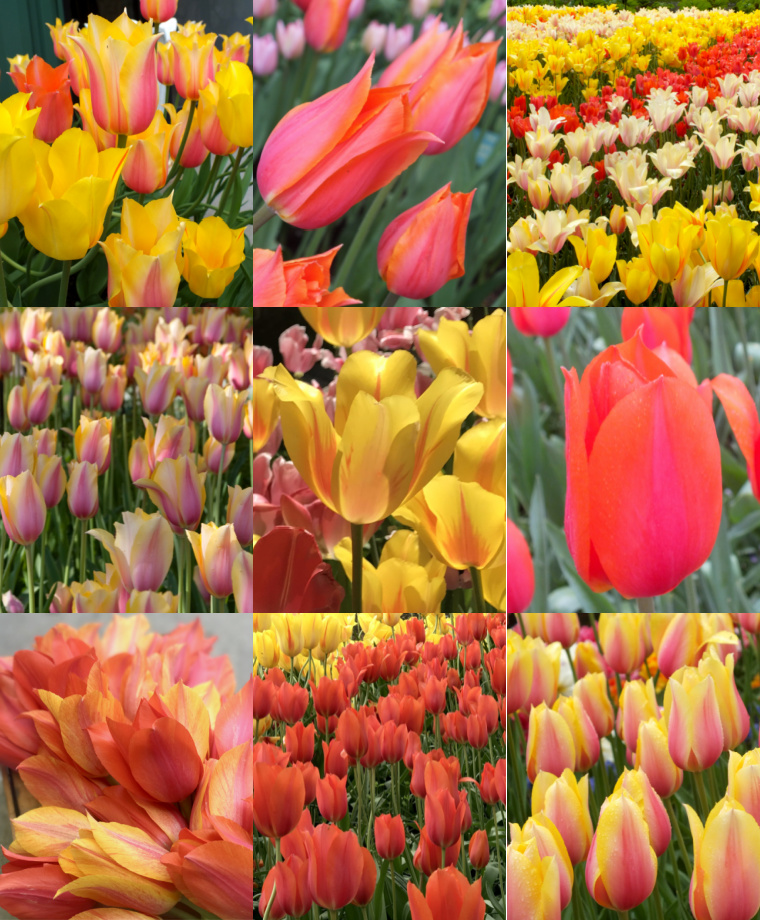
Lefeber Tulips
The first Tulip to be known as a Lefeber Hybrid, the original one, was Single Late Tulip Temple of Beauty. Hybridized by Dirk W. Lefeber, Temple of Beauty was the result of a cross between Lily Flowering Tulip Mariette and a Greigii.
Registered in 1959, Temple of Beauty, a genetically strong triploid, was honored with the venerable Trial Garden Award of the Royal General Bulbgrowers Association (TGA-KAVB) in 1972 and with the revered Award of Garden Merit by the British Royal Horticultural Society (AGM-RHS) in 1993. Since 1959, there have been many off-springs of Temple of Beauty including Tulips Big Brother (2001), Blushing Beauty (1983), Blushing Lady (1991), El Niño (2002), Hocus Pocus (1983), Long Lady (2000), Perestroyka (1990) and Temple’s Favorite (1984). One of our favorite mixtures of Tulips is our Tall Sherbet Tulip Mixture, a blend of Lefeber Tulips Big Brother, Blushing Lady, El Niño, Hocus Pocus and Temple's Favorite.
The tightly wrapped, pointed buds of Lefeber Tulips disguise the largesse of the flowers once they unfurl. Lefeber Hybrid Tulips have huge, vigorous flowers with an elongated, fluted vase shape, pointed petals and often, mottled foliage, due to its Greigii lineage. On a warm spring day, some of these hybrids exude a pale fragrance, like Big Brother and El Niño. Long-lasting Lefeber Hybrids are the tallest Tulips of all, growing to around 30” tall. They open fully on bright, sunny days and close at night, or on dismal days. When they’re fully open, revealing interior striations and streaks, it’s hard to imagine that they could ever fully close into perfect form again. Sometimes, these enormous varieties are referred to as Giant Lefeber Hybrids.
The history of Dirk W. Lefeber’s life is fascinating. It is intertwined with the Netherland’s preeminence in hybridizing and selling flower bulbs all over the world.
Lefeber was born in 1894 in Lisse, the town where the Keukenhof is located in the old flower bulb district. According to a January 2008 article by Arie in 't Veld in a newsletter of the Cultural-Historical Association Old Lisse, Lefeber traveled to England, Germany, the United States and Russia to sell bulbs at a young age. In fact, as the Netherlands was neutral during World War 1, he traveled to Russia in 1917 but was unable to sell one bulb or even to return to the Netherlands for seven months due to the circumstances of the Russian Revolution. These travels were particularly notable at the time since transportation was not easy and it was necessary to learn a rudimentary understanding of the foreign language.
After returning to the Netherlands, Lefeber started hybridizing new varieties of Tulips, Narcissi, Hyacinths and Gladiolus. He was most famous for his Tulip hybridization and received The Lindley Medal from the Royal Horticultural Society for it. He focused on creating new varieties of Tulips that were healthy, good growers as well as beautiful and new.
Dirk W. Lefeber introduced the class of Darwin Hybrid Tulips in 1943 after crossing Darwin Tulips with species T. fosteriana, known for its impeccable strength, good health and beautiful foliage. Lefeber is responsible for the hybridization of numerous outstanding varieties in our collection, like Tulips Angelique, Madame Lefeber (Red Emperor) and Parade.
Another famous Lefeber Darwin Hybrid Tulip is Gudoshnik, registered in 1952. Gudoshnik means painter in Russian, a name of personal, historical significance since Lefeber was one of the first to sell Tulips in Russia. He maintained his connection to Russia: it was reported that Lefeber brought some 30,000 bulbs in his suitcases as a gift to the Russian people from Dutch bulb growers after WWII. Tulip Gudoshnik won the AM-KAVB award in 1958.
Dirk W. Lefeber passed away in 1979 at the age of 85.
Pictured, left to right, top to bottom: The Tall Sherbet Tulip Mixture, Big Brother, Ribbons of Lefebers, Blushing Lady, Hocus Pocus, Temple's Favorite, El Niño, Temple of Beauty, Blushing Beauty.




